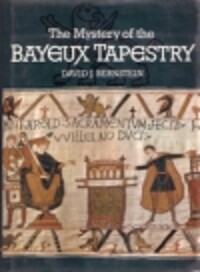Status
Available
Call number
Collection
Publication
Chicago : University of Chicago Press, 1987, c1986.
User reviews
LibraryThing member Lukerik
An excellent first book to read on the subject. I’ve not seen the American edition, but the British one is a well made hardback, pleasingly heavy, on good paper. And oversized so you can actually see the illustrations, of which there many.
At the back is a full reproduction of the tapestry and
In the final part of the book Bernstein argues that the artist is deliberately drawing comparisons between the Norman conquest and the Babylonian conquest of the Jews in 586 BC. I can’t be sure because this is the first book I’ve read on the subject, but I suspect this interpretation may be controversial. When I’d ‘read’ through the tapestry earlier I’d noticed that at one point Harold appears to swear his oath on the Ark of the Covenant. And I was pretty sure it was the Ark because I’ve seen Indiana Jones. I didn’t think much about it at the time. If you’d asked me I probably would have said that people simply built reliquaries that looked like it. Bernstein argues that the artist is signalling here and in other places to an interpretation of events that would not be obvious to his Norman patron. Earlier in the book Bernstein had examined and rejected the analysis of a chap called Werckmeister that the tapestry took inspiration from Trajan’s column. I note that Bernstein’s argument for his own hobby-horse is essentially that same as that he rejected for Werckmeister. But then I had found his argument for the rejection of Werckmeister’s theory to be unconvincing. What Bernstein lacks in his argument is a smoking gun. He can see that details in the tapestry appear to reference details from the Old Testament pseudepigrapha that by the date of the tapestry had passed into Jewish folklore. What he can’t prove is that the artist was aware of the folklore. As it happens, I’ve read those pseudepigrapha and in many cases you have a base Jewish text, abandoned when the Jews closed their Canon, but then taken up, used and amended by Christians over the following centuries. Personally, I find his argument convincing.
At the back is a full reproduction of the tapestry and
Show More
Bernstein opens the book by talking you through it narratively. Then there’s a section on history and provenance before he delves into the art and teases out some fascinating details that normal people just wouldn’t notice. It’s a close examination and at one point, on the question of which one Harold is, he goes literally stitch by stitch. He’s good at summarising other scholars’ opinions before giving his own, all cogently argued.In the final part of the book Bernstein argues that the artist is deliberately drawing comparisons between the Norman conquest and the Babylonian conquest of the Jews in 586 BC. I can’t be sure because this is the first book I’ve read on the subject, but I suspect this interpretation may be controversial. When I’d ‘read’ through the tapestry earlier I’d noticed that at one point Harold appears to swear his oath on the Ark of the Covenant. And I was pretty sure it was the Ark because I’ve seen Indiana Jones. I didn’t think much about it at the time. If you’d asked me I probably would have said that people simply built reliquaries that looked like it. Bernstein argues that the artist is signalling here and in other places to an interpretation of events that would not be obvious to his Norman patron. Earlier in the book Bernstein had examined and rejected the analysis of a chap called Werckmeister that the tapestry took inspiration from Trajan’s column. I note that Bernstein’s argument for his own hobby-horse is essentially that same as that he rejected for Werckmeister. But then I had found his argument for the rejection of Werckmeister’s theory to be unconvincing. What Bernstein lacks in his argument is a smoking gun. He can see that details in the tapestry appear to reference details from the Old Testament pseudepigrapha that by the date of the tapestry had passed into Jewish folklore. What he can’t prove is that the artist was aware of the folklore. As it happens, I’ve read those pseudepigrapha and in many cases you have a base Jewish text, abandoned when the Jews closed their Canon, but then taken up, used and amended by Christians over the following centuries. Personally, I find his argument convincing.
Show Less
Subjects
Language
Physical description
272 p.; 27 cm
ISBN
0226044009 / 9780226044002
